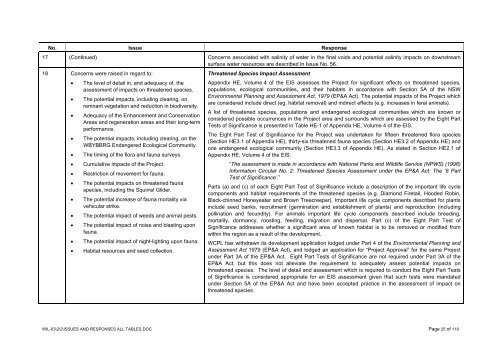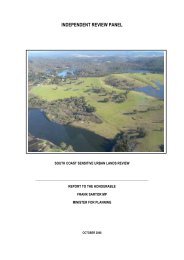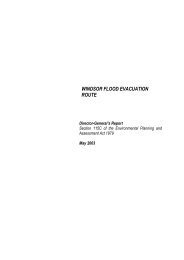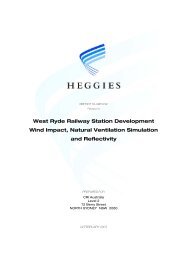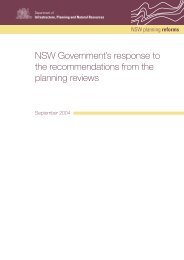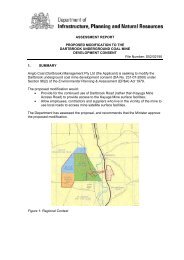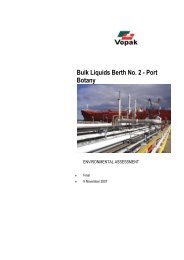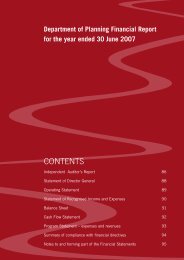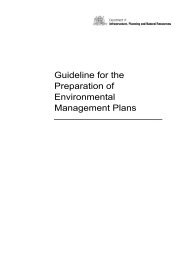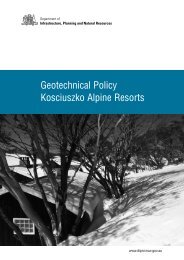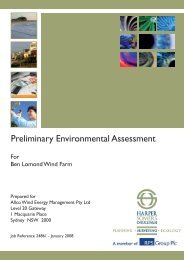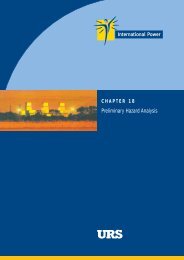wilpinjong coal project wilpinjong coal project - Department of ...
wilpinjong coal project wilpinjong coal project - Department of ...
wilpinjong coal project wilpinjong coal project - Department of ...
Create successful ePaper yourself
Turn your PDF publications into a flip-book with our unique Google optimized e-Paper software.
No. Issue Response<br />
17 (Continued) Concerns associated with salinity <strong>of</strong> water in the final voids and potential salinity impacts on downstream<br />
surface water resources are described in Issue No. 56.<br />
18 Concerns were raised in regard to:<br />
• The level <strong>of</strong> detail in, and adequacy <strong>of</strong>, the<br />
assessment <strong>of</strong> impacts on threatened species.<br />
• The potential impacts, including clearing, on<br />
remnant vegetation and reduction in biodiversity.<br />
• Adequacy <strong>of</strong> the Enhancement and Conservation<br />
Areas and regeneration areas and their long-term<br />
performance.<br />
• The potential impacts, including clearing, on the<br />
WBYBBRG Endangered Ecological Community.<br />
• The timing <strong>of</strong> the flora and fauna surveys.<br />
• Cumulative impacts <strong>of</strong> the Project.<br />
• Restriction <strong>of</strong> movement for fauna.<br />
• The potential impacts on threatened fauna<br />
species, including the Squirrel Glider.<br />
• The potential increase <strong>of</strong> fauna mortality via<br />
vehicular strike.<br />
• The potential impact <strong>of</strong> weeds and animal pests.<br />
• The potential impact <strong>of</strong> noise and blasting upon<br />
fauna.<br />
• The potential impact <strong>of</strong> night-lighting upon fauna.<br />
• Habitat resources and seed collection.<br />
Threatened Species Impact Assessment<br />
Appendix HE, Volume 4 <strong>of</strong> the EIS assesses the Project for significant effects on threatened species,<br />
populations, ecological communities, and their habitats in accordance with Section 5A <strong>of</strong> the NSW<br />
Environmental Planning and Assessment Act, 1979 (EP&A Act). The potential impacts <strong>of</strong> the Project which<br />
are considered include direct (eg. habitat removal) and indirect effects (e.g. increases in feral animals).<br />
A list <strong>of</strong> threatened species, populations and endangered ecological communities which are known or<br />
considered possible occurrences in the Project area and surrounds which are assessed by the Eight Part<br />
Tests <strong>of</strong> Significance is presented in Table HE-1 <strong>of</strong> Appendix HE, Volume 4 <strong>of</strong> the EIS.<br />
The Eight Part Test <strong>of</strong> Significance for the Project was undertaken for fifteen threatened flora species<br />
(Section HE3.1 <strong>of</strong> Appendix HE), thirty-six threatened fauna species (Section HE3.2 <strong>of</strong> Appendix HE) and<br />
one endangered ecological community (Section HE3.3 <strong>of</strong> Appendix HE). As stated in Section HE2.1 <strong>of</strong><br />
Appendix HE, Volume 4 <strong>of</strong> the EIS:<br />
“The assessment is made in accordance with National Parks and Wildlife Service (NPWS) (1996)<br />
Information Circular No. 2: Threatened Species Assessment under the EP&A Act: The ‘8 Part<br />
Test <strong>of</strong> Significance’.”<br />
Parts (a) and (c) <strong>of</strong> each Eight Part Test <strong>of</strong> Significance include a description <strong>of</strong> the important life cycle<br />
components and habitat requirements <strong>of</strong> the threatened species (e.g. Diamond Firetail, Hooded Robin,<br />
Black-chinned Honeyeater and Brown Treecreeper). Important life cycle components described for plants<br />
include seed banks, recruitment (germination and establishment <strong>of</strong> plants) and reproduction (including<br />
pollination and fecundity). For animals important life cycle components described include breeding,<br />
mortality, dormancy, roosting, feeding, migration and dispersal. Part (c) <strong>of</strong> the Eight Part Test <strong>of</strong><br />
Significance addresses whether a significant area <strong>of</strong> known habitat is to be removed or modified from<br />
within the region as a result <strong>of</strong> the development.<br />
WCPL has withdrawn its development application lodged under Part 4 <strong>of</strong> the Environmental Planning and<br />
Assessment Act 1979 (EP&A Act), and lodged an application for “Project Approval” for the same Project<br />
under Part 3A <strong>of</strong> the EP&A Act. Eight Part Tests <strong>of</strong> Significance are not required under Part 3A <strong>of</strong> the<br />
EP&A Act, but this does not alleviate the requirement to adequately assess potential impacts on<br />
threatened species. The level <strong>of</strong> detail and assessment which is required to conduct the Eight Part Tests<br />
<strong>of</strong> Significance is considered appropriate for an EIS assessment given that such tests were mandated<br />
under Section 5A <strong>of</strong> the EP&A Act and have been accepted practice in the assessment <strong>of</strong> impact on<br />
threatened species.<br />
WIL-03\2\2\ISSUES AND RESPONSES ALL TABLES.DOC Page 25 <strong>of</strong> 119


